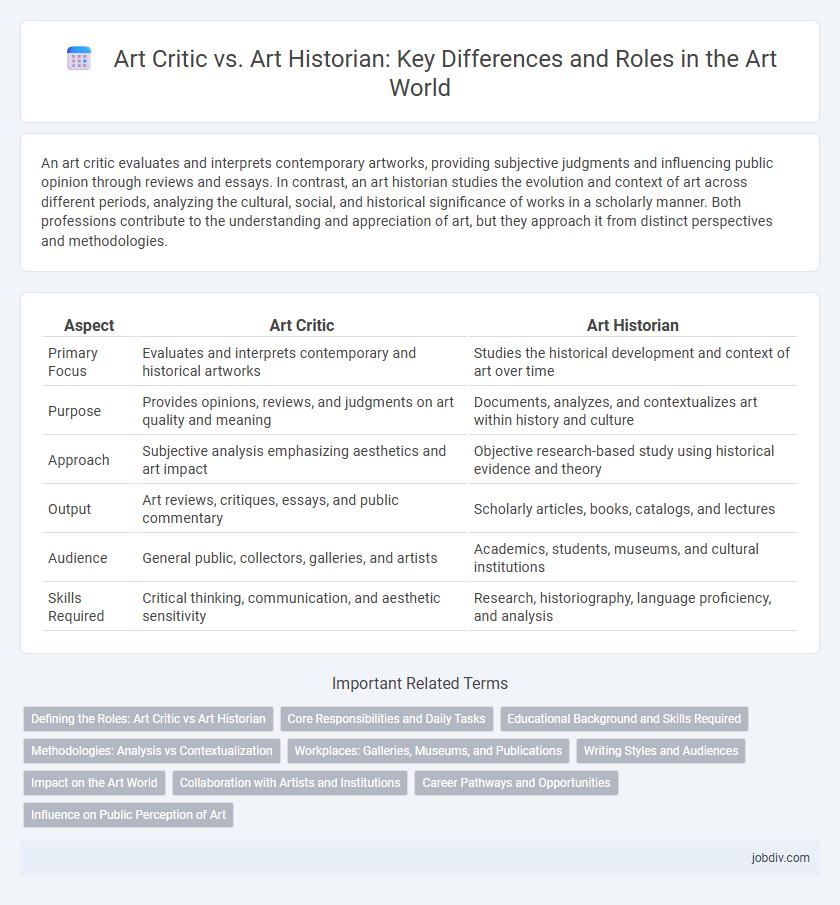An art critic evaluates and interprets contemporary artworks, providing subjective judgments and influencing public opinion through reviews and essays. In contrast, an art historian studies the evolution and context of art across different periods, analyzing the cultural, social, and historical significance of works in a scholarly manner. Both professions contribute to the understanding and appreciation of art, but they approach it from distinct perspectives and methodologies.
Table of Comparison
| Aspect | Art Critic | Art Historian |
|---|---|---|
| Primary Focus | Evaluates and interprets contemporary and historical artworks | Studies the historical development and context of art over time |
| Purpose | Provides opinions, reviews, and judgments on art quality and meaning | Documents, analyzes, and contextualizes art within history and culture |
| Approach | Subjective analysis emphasizing aesthetics and art impact | Objective research-based study using historical evidence and theory |
| Output | Art reviews, critiques, essays, and public commentary | Scholarly articles, books, catalogs, and lectures |
| Audience | General public, collectors, galleries, and artists | Academics, students, museums, and cultural institutions |
| Skills Required | Critical thinking, communication, and aesthetic sensitivity | Research, historiography, language proficiency, and analysis |
Defining the Roles: Art Critic vs Art Historian
An art critic evaluates contemporary artworks, offering subjective interpretations and judgments that influence public perception and market trends. An art historian analyzes art within historical, cultural, and social contexts, tracing developments across periods to understand artistic movements and their significance. The roles differ by emphasis: critics prioritize current relevance and aesthetic impact, while historians focus on contextual research and chronological narrative.
Core Responsibilities and Daily Tasks
Art critics analyze and evaluate contemporary artworks, providing timely reviews that influence public perception and market trends. Art historians research historical contexts, trace artistic movements, and document the evolution of art through scholarly writing and teaching. Both roles require deep knowledge of art theory, but critics focus on current exhibitions while historians concentrate on archival research and preservation.
Educational Background and Skills Required
Art critics typically possess degrees in art history, fine arts, or journalism, emphasizing strong writing skills and contemporary art analysis. Art historians often hold advanced academic qualifications such as a Master's or PhD in art history, focusing on research methodologies, historical context, and archival work. Both roles demand a deep understanding of artistic movements, but critics require rapid evaluative skills while historians prioritize extensive scholarly research.
Methodologies: Analysis vs Contextualization
Art critics primarily employ methodologies centered on detailed visual analysis, evaluating elements like composition, technique, and emotional impact to interpret an artwork's meaning and value. In contrast, art historians emphasize contextualization, examining the historical, cultural, and social circumstances surrounding an artwork's creation to understand its significance and evolution within art movements. Together, these approaches provide a comprehensive understanding by balancing immediate aesthetic experience with broader historical narratives.
Workplaces: Galleries, Museums, and Publications
Art critics primarily work in galleries, museums, and publications, providing real-time evaluations and reviews of contemporary art exhibitions and artists' works. Art historians predominantly engage in museums, academic institutions, and research publications, analyzing historical contexts and art movements across centuries. Both professionals contribute to the art world, with critics influencing public opinion and market trends, while historians offer in-depth scholarly insight and preservation of art heritage.
Writing Styles and Audiences
Art critics employ a dynamic and persuasive writing style aimed at influencing public opinion and guiding contemporary art appreciation, targeting a broad audience including collectors, galleries, and general art enthusiasts. Art historians utilize a more formal, research-based approach with detailed analysis and extensive contextual background, appealing primarily to academics, students, and museum professionals. The contrast in writing styles reflects their different objectives: critics respond to current artistic trends, while historians focus on comprehensive studies of art movements and historical significance.
Impact on the Art World
Art critics shape contemporary art appreciation by influencing public opinion and market trends through their reviews and essays, often determining an artist's commercial success and cultural relevance. Art historians impact the art world by providing scholarly research and contextual analysis that deepen understanding of artistic movements, styles, and historical significance. Both roles are essential: critics drive immediate discourse and trends, while historians preserve and interpret the legacy of art across time.
Collaboration with Artists and Institutions
Art critics often collaborate directly with artists and galleries to provide contemporary evaluations that influence public perception and market trends. Art historians engage with museums, archives, and academic institutions to research and document the cultural significance and provenance of artworks over time. Both roles contribute uniquely to art discourse, with critics shaping immediate reception and historians ensuring long-term contextual understanding.
Career Pathways and Opportunities
Art critics analyze and interpret contemporary artworks, publishing reviews in galleries, magazines, and online platforms, often requiring strong communication skills and a background in journalism or art theory. Art historians research and study art movements, artists, and historical contexts, typically working in academia, museums, or cultural institutions, with careers focused on education, curatorial work, and scholarly publishing. Both professions demand deep art knowledge, but critics engage directly with current art scenes while historians emphasize historical analysis, offering distinct yet complementary career pathways in the art world.
Influence on Public Perception of Art
Art critics shape public perception by offering immediate interpretations and evaluative judgments that can elevate or diminish an artwork's reputation. Art historians provide contextual analysis by tracing an artwork's origins, cultural significance, and historical development, enriching the audience's understanding over time. Together, their insights influence how art is valued, interpreted, and integrated into cultural discourse.
Art Critic vs Art Historian Infographic

 jobdiv.com
jobdiv.com